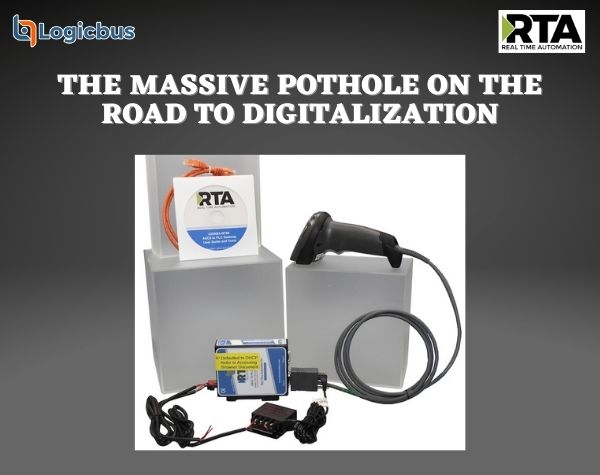I’m sure it’s unique to me but when I sit at my desk to work, I first have to remove all the sharp objects from my desk – anything that could be used to penetrate the soft tissue of my brain. You see, a significant portion of my job is reading articles in trade newsletters, trade magazines and on LinkedIn. I read quite a few, and lately, the digitalization articles are inciting thoughts of self-harm.
What you may not understand is that for about the last two or three years, the intro to every article I read is nearly identical. The first 1/3 describes the benefits of digitalization in much the same way as every other article. And not succinctly either. Some expand on the explanation of digitalization, the IoT Edge, Industry 4.0 and all the rest to fill two or three pages of redundant babble. I’ve started cataloging common sentences and this one is currently on the leader board:
“Industry 4.0 and digitalization promises to transform industries worldwide to achieve fully optimized and predictable asset performance”
It’s not that I disagree with Industry 4.0 and digitalization. I think that most of the objectives are as admirable as they are ambitious:
-
Establishing wired, wireless and Single Pair Ethernet as the sole physical layer for factory communications.
-
Establishing a single communications standard to support everything from sensor to cloud communications. OPC UA Field Level Communications (FLC) standardization efforts are moving in this very direction with even more sophisticated data modeling, automation component standardization and a Time Sensitive Network (TSN) for Ethernet deterministic behavior.
-
Decoupling of the hardware platforms from software applications such that any application can run anywhere on the factory floor.
-
Evolving PLC programming into a high-level system design language supporting distributed information and control systems. The IEC 61499 standard, an extension of 61131-3 and currently implemented by Schneider Electric in the EcoStruxture Automation Expert, is the first step in this direction.
-
Radically reshaping of the IT and OT departments. Restructuring such that IT can worry about networks, storage, resources, containers, load balancers and the like while OT can manage applications, processes and devices. The purview of IT becomes every network in the plant. The controls organization deploys applications on the resources provided by IT.
-
Enabling Machine Learning and Artificial Intelligence at the edge such that data can be processed and responded to quickly.
It’s probably true that there would be huge savings if this were to come to pass. The ARC Advisory Group recently estimated that the DCS services market alone is $20 to $30 billion dollars and a substantial part of that, I’d think as much as $5 to $10 billion dollars, could be saved by implementing these changes. And that’s just in-process automation.
RESHAPING, DISRUPTING AND TRANSFORMING INDUSTRIAL AUTOMATION
What this digitalization effort portends is a radical reshaping of the manufacturing and plant environment unlike any since the introduction of programmable logic control in the 1970s. Many of the sharper pundits writing about manufacturing describing why this will happen point to radical transformations in other sectors of the economy:
-
Transportation – A complete transformation of how people move about our cities.
-
Music – Live to recorded with Edison’s “talking machine”. Small music shops replaced by gigantic record stores supplanted by CDs and personal listening devices (Sony Walkman) and now transformed by digital businesses like Spotify and Pandora.
-
Movies – Silent disrupted by “talkies”. Theaters disrupted by Video Cassette Recordings (VCR) and DVDs controlled for a time by Blockbuster and now unseated by Netflix.
-
Film – Chemical film eliminated by digital technology.
-
Internal combustion engine – 100 years of operation now being disrupted by electric vehicles.
Many believe that this kind of disruption is coming to a manufacturer near you. They believe it is possible to disrupt the interlocking ecosystems of the major suppliers, distributors and integrators as well as the customers organizations with operations designed for compatibility with that ecosystem. This system would be replaced with an entirely new industrial ecosystem of new suppliers, new distributors and new integrators adept at deploying new Industry 4.0 tools, processes and methodologies.
Prerequisites
For all this to come about, the prerequisites are clear:
Manufacturers must believe that massive value is obtainable – manufacturers must come to believe that the benefits of digitalization – substantial savings, profits and efficiencies – can come from the pain of this kind of transformation.
Manufacturers must be willing to reinvent their organizations – the complete implementation of digitalization portends a massive restructuring and reorganization of the responsibilities, roles and processes of both IT and OT. IT would have to take on the role of providing and supporting networking resources to the lowest level of the automation hierarchy. OT would change its role to become a manager of applications that run on the network equipment provided by IT.
The Tools must be available, well-understood and standardized – the digital transformation cannot happen without the platforms, software and tools supporting it. Vendors would have to provide the open hardware systems, virtual containers and operating systems to power edge devices. Software vendors would have to provide the plethora of open application tools to build the applications. Certification standards would have to be in place to govern how these open systems interact and exchange I/O and data.
There must be a smooth path from here to there – Unlike other kinds of digital transformations we’ve seen in music, transportation, film and others, a digital transformation of manufacturing won’t happen as a step function. There has to be a smooth path from the semi-closed ecosystems of today to the open systems of tomorrow.
None of this is impossible but there has to be a tipping point.
THE TIPPING POINT FOR DIGITALIZATION
A tipping point is the point at which a series of small changes or incidents beyond which a significant and often irreversible effect or change takes place. It’s not apparent what kind of tipping point would swing the entire automation industry to open systems and digitalization. Vendors with large ecosystems of consultants, suppliers and distributors all have a massive, vested interest in maintaining a non-digital future.
Allen-Bradley is the market leader in North America with a truly massive ecosystem of partners, suppliers, distributors, integrators and end-users that all have a common, vested interest in maintaining the current environment. AB has been at the pivot point of almost every turn in the manufacturing world. Not the first to market with a PLC but they had the first widely used one. They were the market leader that promoted DeviceNet, tipping the industry from direct connect IO to networking. Ethernet on the factory floor became accepted when they adopted EtherNet/IP. Buying ICOM – the first provider of programming tools on Windows – moved the automation industry to adopt windows-based PLC programming.
Each of these minor tipping points changed the direction of manufacturing automation but also served to solidify and enhance Allen-Bradley’s overall business. None were an existential threat to it. But now, the proponents of digitalization would have us believe that somehow that entire ecosystem in the US and elsewhere is going to readily agree to open systems, open hardware and run anywhere open software that threatens both current product lines and business models. It’s truthfully hard to envision such a thing or a tipping point that would lead to it.
PackML is a specific case in point. PackML, an undeniably superior way of operating packaging machines, was never fully adopted it by the large packaging companies and their vendors were never required to support it. This is a case of superior technology, proven to be easier to use, providing increase efficiencies with lower costs never reaching a tipping point as the current vendor/user ecosystem never fully embraced the changes that were required.
SIGNIFICANT DIGITALIZATION IS A LONG WAY OFF
Despite the benefits of digitalization, it’s apparent that the interlocking ecosystems of trade organizations, vendors and user organizations are going to slow the adoption of any technologies and processes that disrupt the prevailing order. There is too much money, the ecosystems are too integrated and organizations just won’t change fast enough for a real tipping point that leads to massive change. We can, we should and we are beginning to move toward digitalization but it will be within the confines of current controllers, non-Ethernet legacy technologies and organizations that will only haltingly integrate IT and OT.
A future where a majority of manufacturing automation systems are running on open platforms, the majority of process and discrete automation is using Ethernet, control programming is app-based using network resources provided by IT looks to be far over the horizon. There are too many cultural, organizational, and financial roadblocks that are going to prevent widespread digitalization in the near future. Instead, we can look for very gradual, almost glacial change as the current ecosystem players slowly transform to a digital manufacturing world.
Visit our website:
www.logicbus.com




sales@logicbus.com | support@logicbus.com | +1 619 616 7350 | Start conversation

